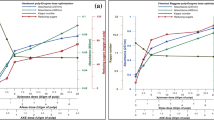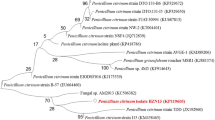Abstract
Recycling of civic paper waste by enzyme-based technology is nowadays a point of much concern for pollution-less green environment. In this study, the deinking effectiveness of purified xylanase from a newly isolated bacterium was evaluated for recycling of laser jet paper waste. A potent xylanases-producing bacterium from the microbial consortia of termite gut was isolated, which was further identified on the basis of 16S rRNA sequence as Bacillus sp. CKBx1D. In submerged fermentation condition, the isolate produced the highest level of xylanase (480 U/ml) at 36 h of growth. The extracellular xylanase system comprises of three distinct isozymes (est. Mw 35.28, 28.63, 18.94 kDa). The deinking of laser printed paper waste was performed using the purified enzyme mixture. Whole operational parameters were optimized using the Response Surface Methodology; it was found that at pH 6.8 with 47.2 h of continuous shaking at constant temperature of 35 °C, enzymes showed best deinking activity. After enzyme treatment, the physical properties of the pulp like brightness and ERIC (effective residual ink content) values were enhanced, whereas the pulp opacity was more reduced than the control treatment. Hence, the bacterial isolate and its xylanolytic enzyme system could efficiently be used in recycling paper waste as deinking agent.






Similar content being viewed by others
References
Facts about paper and paper waste (2010). Available from: www.id2.ca. Accessed October, 2011.
MacFadden, T., & Vogel, M. P. (1996). Facts about paper. USA: Printers' National Environmental Assistance Center, Montana State University.
Bajpai, P., & Bajpai, P. K. (1998). Deinking with enzyme: a review. TAPPI Journal, 81, 111–117.
Prasad, D. Y., Heitmann, J. A., & Joyce, T. W. (1993). Enzymatic deinking of colored offset newsprint. Nordic Pulp & Paper Research Journal, 2, 284–286.
Nie, X., Miller, J. D., & Yeboah, Y. D. (1998). The effect of ink types and printing processes on flotation deinking efficiency of wastepaper recycling. Environmental Engineering and Policy, 1, 47–58.
Nie, X., & Miller, J. D. (1997). The effect of ink types and printing process on flotation deinking. TAPPI Proceedings Recycling Symposium, pp. 131–147.
Call, H. P., & Strittmatter, G. (1992). Application of ligninolytic enzymes in the paper and pulp industry–recent results. Papier, 46, 32–37.
Gübitz, G. M., Mansfield, S. D., Böhm, D., & Saddler, J. N. (1998). Effect of endoglucanases and hemicellulases in magnetic and flotation deinking of xerographic and laser-printed papers. Journal of Biotechnology, 65, 209–215.
Morkbak, A. L., Degn, P., & Zimmermann, W. (1999). Deinking of soybean oil based ink-printed paper with lipases and a neutral surfactant. Journal of Biotechnology, 67, 229–236.
Lee, C. K., Darah, I., & Ibrahim, C. O. (2007). Enzymatic deinking of laser printed office waste papers: some governing parameters on deinking efficiency. Bioresource Technology, 98, 1684–1689.
Kim, T. J., Ow, S. S. K., & Eom, T. J. (1991). Enzymatic deinking method of wastepaper. In: Proceedings of TAPPI Pulping Conference, pp. 1023–1031.
Pala, H., Mota, M., & Gama, F. M. (2004). Enzymatic versus chemical deinking of non-impact ink printed paper. Journal of Biotechnology, 108, 79–89.
Mandal, A., Kar, S., Das Mohapatra, P. K., Maity, C., Pati, B. R., & Mondal, K. C. (2011). Purification and characterization of an endoxylanase from the culture broth of Bacillus cereus BSA1. Applied Biochemistry and Microbiology, 47, 250–255.
Faik, A. (2010). Xylan Biosynthesis: news from the grass. Plant Physiology, 153, 396–402.
Ghosh, M., Amitabha, D., Mishra, A. K., & Nanda, G. (1993). Aspergillus sydowwi MG 49 is a strong producer of thermostable xylanolytic enzymes. Enzyme and Microbial Technology, 15, 703–709.
Gilbert, H. J., & Hazlewood, G. P. (1999). Bacterial cellulase and xylanase. Journal of General Microbiology, 139, 187–194.
Sanghi, A., Garg, N., Kuhar, K., Kuhad, R. C., & Gupta, V. K. (2009). Enhanced production of cellulase-free xylanase by alkalophilic Bacillus subtilis ASH and its application in biobleaching of kraft pulp. BioResources, 4, 1109–1129.
Dhiman, S. S., Garg, G., Mahajan, R., Garg, N., & Sharma, J. (2009). Single lay out and mixed lay out enzymatic processes for bio-bleaching of kraft pulp. Bioresource Technology, 100, 4736–4741.
Ninawe, S., Kapoor, M., & Kuhad, R. C. (2007). Purification and characterization of extracellular xylanase from Streptomyces cyaneus SN32. Bioresource Technology, 99, 1252–1258.
Pal, A., & Khanum, F. (2010). Characterizing and improving the thermostability of purified xylanase from Aspergillus niger DFR-5 grown on solid-state-medium. Journal of Biochemical Technology, 2, 203–209.
Viikari, L., Kantelinen, A., Sundquist, J., & Linko, M. (1994). Xylanases in bleaching: from an idea to the industry. FEMS Microbiology Review, 13, 335–350.
Blanco, A., Vidal, T., Colom, J. F., & Pastor, J. F. I. (1995). Purification and properties of xylanase A from alkali-tolerant Bacillus sp. Strain BP-23. Applied and Environmental Microbiology, 61, 4468–4470.
Bajpai, P. (1999). Application of enzymes in the pulp and paper industry. Biotechnology Progress, 15, 147–157.
Maity, C., Samanta, S., Halder, S. K., Das Mohapatra, P. K., Pati, B. R., Jana, M., & Mondal, K. C. (2011). Isozymes of α-amylases from newly isolated Bacillus thuringiensis CKB19: production from immobilized cells. Biotechnology and Bioprocess Engineering, 16, 312–319.
Xu, Z., Miao, Y., Chen, J. Y., Jiang, X., Lin, L., & Ouyang, P. (2011). Co-immobilization mechanism of cellulase and xylanase on a reversibly soluble polymer. Applied Biochemistry and Biotechnology, 163, 153–161.
Miller, G. L. (1959). Use of dinitrosalicylic acid reagent for determination of reducing sugar. Analytical Chemistry, 31, 426–428.
Lowry, O. H., Rosebrough, N. J., Farr, A. L., & Randall, R. J. (1951). Protein measurement with the folin phenol reagent. Journal of Biological Chemistry, 193, 265–275.
Min-Jen, T., Mee-Nagan, Y., Khanok, R., Khin Lay, K., & Shui-Tein, C. (2002). Purification and characterization of two cellulase free xylanases from an alkaliphilic Bacillus firmus. Enzyme and Microbial Technology, 30, 590–595.
Roe, S. (2000). Protein purification techniques (2nd ed.). Oxford: Oxford University Press.
Jordan, B. D., & Popson, S. J. (1994). Measuring the concentration of residual ink in recycled newsprint. Journal of Pulp and Paper Science, 20, J161–J167.
Saitou, N., & Nei, M. (1987). The neighbor-joining method: a new method for reconstructing phylogenetic trees. Molecular Biology and Evolution, 4, 406–425.
Wenzel, M., Schönig, M., Berchtold, M., Kämpfer, P., & König, H. (2002). Aerobic and facultatively anaerobic cellulolytic bacteria from the gut of the termite Zootermopsis angusticollis. Journal of Applied Microbiology, 92, 32–40.
Konig, H. (2006). Bacillus species in the intestine of termites and other soil invertebrates. Journal of Applied Microbiology, 101, 620–627.
Nakamura, S., Wakabayashi, K., Nakai, R., Aono, R., & Horikoshi, K. (1993). Purification and some properties of an alkaline xylanase from alkaliphilic Bacillus sp. Strain 41M-1. Applied and Environmental Microbiology, 59, 2311–2316.
Wong, K. Y., Tan, L. U. L., & Saddler, J. N. (1988). Multiplicity of β-1,4-xylanase in microorganisms: functions and applications. Microbiological Reviews, 52, 305–317.
Breccia, J. D., Sineriz, F., Baigori, M. D., Castro, G. R., & Hatti-Kaul, R. (1998). Purification and characterization of a thermostable xylanase from Bacillus amyloliquefaciens. Enzyme and Microbial Technology, 22, 42–49.
Akiba, T., & Horikoshi, K. (1988). Xylanases of alkalophilic thermophilic Bacillus. Methods in Enzymology, 160, 655–659.
Biely, P., Markovik, O., & Mislovicova, D. (1985). Sensitive detection of endo-1,4,-β glucanases and endo-1,4-β-xylanases in gels. Analytical Biochemistry, 144, 147–151.
Elegir, G., Szakacs, G., & Jeffries, T. W. (1994). Purification, characterization and substrate specificities of multiple xylanases from Streptomyces sp. strain B-12-2. Applied and Environmental Microbiology, 60, 2609–2615.
Dobozi, M. S., Szakacs, G., & Bruschi, C. V. (1992). Xylanase activity of Phanerchaete Chrysosporium. Applied and Environmental Microbiology, 58, 3466–3471.
Li, X.-L., & Ljungdahl, L. G. (1994). Cloning, sequencing and regulation of a xylanase gene from the fungus Aureobasidium pullulans Y-2311-1. Applied and Environmental Microbiology, 60, 3160–3166.
Badhan, A. K., Chadha, B. S., Sonia, K. G., Saini, H. S., & Bhat, M. K. (2004). Functionally diverse multiple xylanases of thermophilic fungus Myceliophthora sp. IMI 387099. Enzyme and Microbial Technology, 35, 460–466.
Choudhury, B., Aggarwal, P., Gothwal, R. K., Mantri, R., Mohan, M. K., & Ghosh, P. (2006). Biobleaching of nonwoody pulps using xylanase of Bacillus brevis BISR-062. Applied Biochemistry and Biotechnology, 128, 159–169.
Jeffries, T. W., Klungness, J. H., Sykes, M. S., & Rutledge-Cropsey, K. R. (1994). Comparison of enzyme– enhanced with conventional deinking of xerographic and laser-printed paper. TAPPI Journal, 77, 173–179.
Yingjuan, F., Zhiyong, S., Bingyun, L., Menghus, Q., Peiji, G., & Yue, Z. (2000). Effect of enzyme pretretments on wheat straw. Fourth International Nonwood Fibre Pulping and Paper making Conference Proceeding (China), 2, 549–553.
Gaosheng, W., Junfang, H., Laisu, X., & Anquan, L. Y. (2000). The mechanism of drainage improvement for pulp with enzyme treatment. Fourth International Nonwood Fibre Pulping and Paper making Conference Proceedings, 2, 417–426.
Box, G., & Behnken, D. (1960). Some new three level designs for the study of quantitative variables. Technometrics, 2, 455–475.
Ravikumar, K., Pakshirajan, K., Swaminathan, T., & Balu, K. (2005). Optimization of batch process parameters using response surface methodology for dye removal by a novel adsorbent. Chemical Engineering Journal, 105, 131–138.
Pommier, J., Fuentes, J., & Goma, G. (1989). Using enzymes to improve the process and the product quality in the recycled paper industry: Part 1. The basic laboratory work. TAPPI Journal, 72, 187–191.
Shrinivas, D., Savitha, G., Raviranjan, K., & Naik, G. R. (2010). A highly thermostable alkaline cellulase-free xylanase from thermoalkalophilic Bacillus sp. JB 99 suitable for paper and pulp industry: purification and characterization. Applied Biochemistry and Biotechnology, 162, 2049–2057.
Acknowledgements
The authors are grateful to the Council of Scientific and Industrial Research (CSIR), Govt. of India, New Delhi for financial assistance to carry out this work. We are also thankful to Nandadulal Bhattacharyya, Principal, Vidyasagar Institute of Health (VIH), Midnapore for the meticulous revision of the paper.
Author information
Authors and Affiliations
Corresponding author
Rights and permissions
About this article
Cite this article
Maity, C., Ghosh, K., Halder, S.K. et al. Xylanase Isozymes from the Newly Isolated Bacillus sp. CKBx1D and Optimization of Its Deinking Potentiality. Appl Biochem Biotechnol 167, 1208–1219 (2012). https://doi.org/10.1007/s12010-012-9556-4
Received:
Accepted:
Published:
Issue Date:
DOI: https://doi.org/10.1007/s12010-012-9556-4




